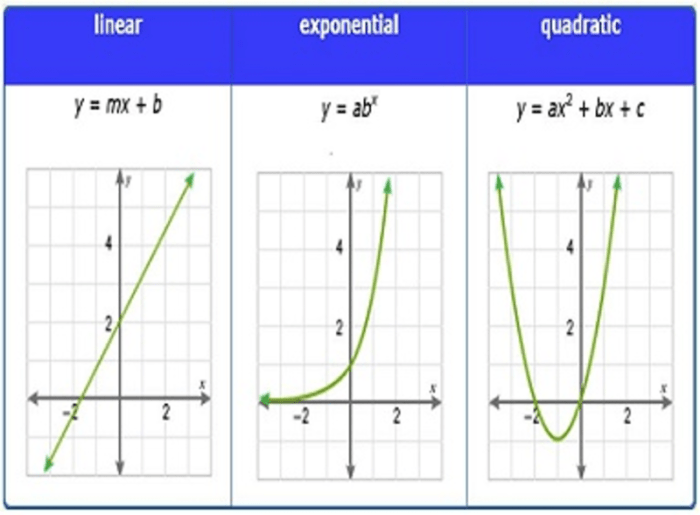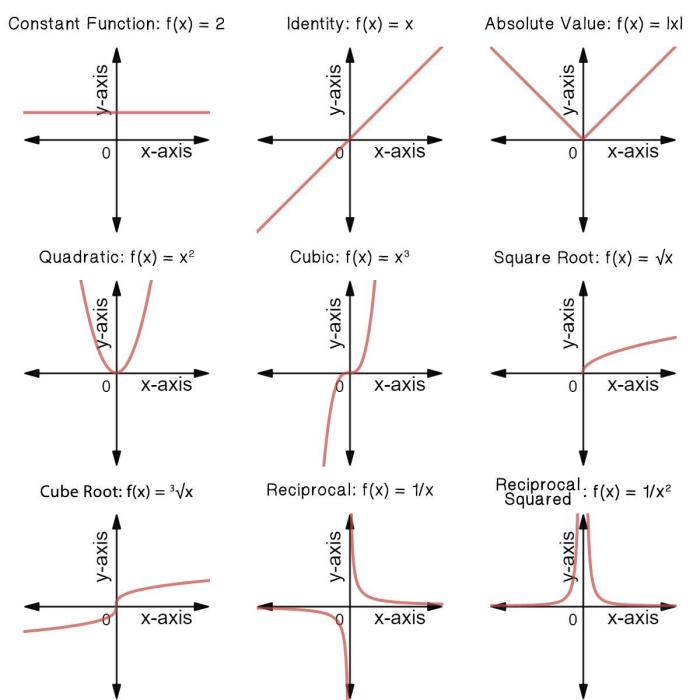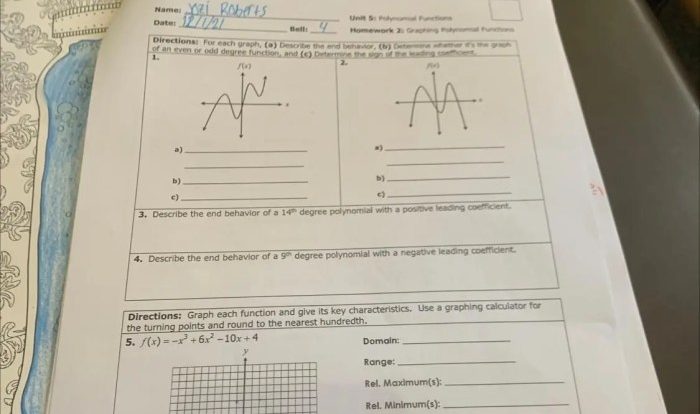Unit 9 linear quadratic and exponential functions – Unit 9: Linear, Quadratic, and Exponential Functions delves into the fundamental concepts and applications of these essential mathematical functions. From the linear relationships that govern everyday phenomena to the exponential growth patterns observed in nature, this unit provides a comprehensive exploration of their properties, transformations, and real-world relevance.
Linear functions, with their constant slope and y-intercept, form the foundation of understanding linear relationships. Quadratic functions, characterized by their parabolic graphs, introduce the concept of vertex and axis of symmetry. Exponential functions, exhibiting remarkable growth or decay patterns, model a wide range of natural and societal phenomena.
Linear Functions
Linear functions represent the simplest type of function, exhibiting a constant rate of change. They are defined by a linear equation of the form y = mx + b, where ‘m’ represents the slope and ‘b’ represents the y-intercept.
For instance, the function y = 2x + 1 represents a line with a slope of 2 and a y-intercept of 1. As ‘x’ increases by one unit, ‘y’ increases by two units, indicating a constant rate of change.
Slope and Y-Intercept
- The slope, ‘m’, describes the steepness of the line. A positive slope indicates an upward trend, while a negative slope indicates a downward trend.
- The y-intercept, ‘b’, represents the point where the line intersects the y-axis.
Quadratic Functions
Quadratic functions, defined by the standard form y = ax^2 + bx + c, exhibit a parabolic shape. They are characterized by a vertex, which represents the highest or lowest point of the parabola.
Vertex and Axis of Symmetry
- The vertex of a quadratic function is given by the coordinates (-b/2a, f(-b/2a)).
- The axis of symmetry, a vertical line passing through the vertex, is given by the equation x = -b/2a.
Solving Quadratic Equations
Quadratic equations can be solved using various methods, including factoring, completing the square, and using the quadratic formula.
Exponential Functions: Unit 9 Linear Quadratic And Exponential Functions

Exponential functions, defined by the form y = a^x, exhibit either exponential growth or decay. The base ‘a’ determines the rate of growth or decay.
Growth and Decay
- When a > 1, the function represents exponential growth, where ‘y’ increases rapidly as ‘x’ increases.
- When 0< a < 1, the function represents exponential decay, where 'y' decreases rapidly as 'x' increases.
Applications, Unit 9 linear quadratic and exponential functions
Exponential functions are widely used in modeling various real-world phenomena, such as population growth, radioactive decay, and financial investments.
Relationships between Functions
Linear, quadratic, and exponential functions exhibit distinct characteristics and relationships.
Similarities
- All three types of functions can be represented graphically.
- They can be used to model real-world scenarios.
Differences
- Linear functions have a constant rate of change, while quadratic functions have a parabolic shape and exponential functions exhibit exponential growth or decay.
- Quadratic functions have a vertex, while exponential functions have an asymptote.
Conversions
In certain cases, it is possible to convert between different types of functions. For example, a linear function can be converted into a quadratic function by adding a quadratic term.
Applications of Functions

Linear, quadratic, and exponential functions find applications in diverse fields.
Linear Functions
- Modeling linear relationships, such as the relationship between distance and time.
- Predicting future values based on historical data.
Quadratic Functions
- Modeling parabolic trajectories, such as the trajectory of a projectile.
- Solving optimization problems, such as finding the maximum or minimum value of a function.
Exponential Functions
- Modeling exponential growth or decay, such as the growth of a population or the decay of a radioactive substance.
- Predicting future trends based on past data.
Extensions

Advanced topics related to linear, quadratic, and exponential functions include:
Transformations
Transformations can be applied to functions to alter their graphs. These include translations, reflections, and stretches.
Matrices and Determinants
Matrices and determinants are used to solve systems of linear equations and find the inverse of a matrix.
Questions Often Asked
What is the key difference between linear and quadratic functions?
Linear functions have a constant rate of change, while quadratic functions have a rate of change that varies depending on the value of the independent variable.
How can I solve a quadratic equation?
There are several methods to solve a quadratic equation, including factoring, completing the square, and using the quadratic formula.
What is the relationship between exponential functions and growth and decay?
Exponential functions model exponential growth or decay, where the rate of change is proportional to the value of the function.
